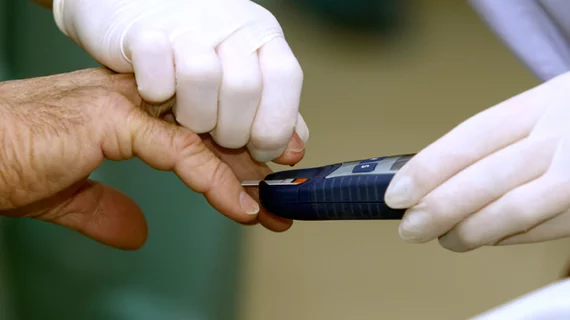Patients with diabetes and peripheral artery disease (PAD) are significantly more likely than nondiabetics with PAD to die from cardiovascular causes or have a heart attack or stroke, according to a subanalysis of the EUCLID trial published online Dec. 17 in the Journal of the American College of Cardiology.
The trial was originally designed to test ticagrelor, a P2Y12 inhibitor, against clopidogrel for reducing major adverse cardiovascular events (MACE) among 13,885 patients with symptomatic PAD. But because 38.5 percent of the cohort had diabetes, lead author Cecilia C. Low Wang, MD, and colleagues said the study population presented a unique opportunity to analyze the effect of diabetes on cardiovascular and adverse limb outcomes among PAD patients.
Three years after study enrollment, the incidence of MACE—which included cardiovascular death, myocardial infarction and stroke—was 15.9 percent among patients with diabetes compared to 10.4 percent among those without diabetes. After adjusting for multiple variables, Wang et al. found diabetics carried a 56 percent higher chance of experiencing one of these outcomes by 36 months.
The quality of glycemic control was found to be important as well, with every 1 percent increase in hemoglobin A1c associated with a 14.2 percent greater risk of MACE.
“Although these findings are perhaps unsurprising, they are novel as one of the largest such analyses, and in the ability to demonstrate a clear ‘dose-response’ with glycemic control,” wrote Ehrin J. Armstrong, MD, MSc, and two colleagues from the University of Colorado School of Medicine, in a related editorial.
“These findings suggest that worsened glycemic control is related to poor outcomes and hold the promise of the converse: that improved glycemic control may curb the persistently demonstrated negative impact of diabetes on cardiovascular events.”
The increases in events among diabetics were consistent across subgroups based on sex, weight, age, kidney function, treatment with clopidogrel or ticagrelor and prior cardiovascular or cerebrovascular disease. However, the risk for major bleeding during treatment wasn’t significantly different among PAD patients based on their diabetes status.
In addition to a higher risk of MACE, patients with diabetes in the study were found to have a 96 percent increased risk for major amputation and a 25 percent increased risk of lower extremity revascularization compared to adults with PAD but no diabetes.
“This increased risk likely reflects macrovascular atherosclerosis, microvascular disease manifest as neuropathy, and the disordered metabolism of diabetes,” Wang et al. wrote. “Lower extremity amputations have been termed a ‘sentinel outcome’ because the risk is affected by the management of glycemia, blood pressure and tobacco use, in addition to the effectiveness of health systems to identify and treat patients with diabetic foot disease.”
The authors noted their results may not apply to patients with asymptomatic PAD or even less severe disease, because the trial only enrolled symptomatic individuals with an ankle-brachial index of 0.80 or lower—reflecting fairly significant PAD. They suggested future studies establish the mechanisms behind the heightened risk observed among diabetics, “and seek pragmatic strategies to reduce this risk.”
One such approach, Armstrong and coauthors wrote in their editorial, is including endocrinologists alongside heart specialists on multidisciplinary care teams.
Recent studies have shown certain diabetes drugs can improve cardiovascular outcomes independent of their glucose-lowering properties, prompting the American College of Cardiology to release an expert consensus document urging cardiologists to take a more active role in prescribing these therapies to patients with the common combination of CVD and diabetes.
“These trials generated excitement and promise for both cardiovascular and endocrine societies, but also foreshadowed more complex decision-making for both endocrine and cardiovascular clinicians as they face relating these clinical data to real-world cohorts,” Armstrong et al. wrote. “With ongoing development and novel assessments of antidiabetic agents, a unique opportunity exists for collaborative growth and establishment of care and management algorithms.”

